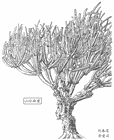
Plant in habitat; near Drang-Drung glacier terminus (elevation 4,130 m) in the Zanskar Valley, India; 2020.10 [Gaurav Verma, Facebook post 2021.10.13].

Plant showing cone-bearing branchlet and seed cones at maturity [Liu Chunrong, redrawn by Li Aili] (Fu et al. 1999, Fig. 111).

A female flower (Ali and Qaiser 1987).

A male flower (Ali and Qaiser 1987).

Left to right: seed cone at maturity; apical bracts; seed; micropylar tube apex [Liu Chunrong, redrawn by Li Aili] (Fu et al. 1999, Fig. 111).

Ephedra gerardiana
Wallich ex Klotzsch & Garcke 1846
Common names
山岭麻黄 Shanling ma huang, asmania.
Taxonomic notes
Two subspecies, the type and Ephedra gerardiana var. sikkimensis Stapf. Synonymy, all for the type subspecies, as follows (Ali and Qaiser 1987, Fu et al. 1999):
- Ephedra distachya auct. non L.
- Ephedra vulgaris sensu Hook. f.
- Ephedra wallichii Stapf.
- Ephedra gerardiana var. congesta C.Y. Cheng
- Ephedra gerardiana var. wallichii Stapf
Type: East India Company Museum, Wallich 6048 (K) (Ali and Qaiser 1987).
Description
Shrubs, 20-120 cm tall and up to 15 cm stem diameter. Woody stems buried in soil, parts above ground scabrous or striate, rarely almost smooth; branchlets ascending, dark green, later brown, short, stout, usually with 1-3 nodes, internodes 1-1.5(-2) cm, diameter 1.5-2 mm, longitudinally furrowed, often scabridulous. Leaves opposite, 2-3 mm long, connate for ca. 2/3 their length. Pollen cones solitary or in clusters of 2-3 at nodes, small, 2-5×2 mm, sessile; bracts in 3 or 4(-6) pairs; staminal column exserted for ca. 1/2 its length, with 5-8 sessile anthers. Flowers 4-8: bracts in 2 or 3 pairs, connate for 1/4-1/3 their length, the apical pair for ca. 2/3 their length, red and fleshy at maturity. Seed cones solitary, sessile or shortly pedunculate, subglobose at maturity, 5-7 mm in diam.; integument tube short, ca. 1 mm. Berry 7-8 mm long, $plusmn;ovoid, red. Seeds 1-2, oblong or obovoid-oblong, 4-6 × 1.5-3 mm, exserted, apex obtuse or subacuminate. Pollination Jul, seed maturity Aug-Sep. 2n = 14, 28, 56 (Ali and Qaiser 1987, Fu et al. 1999).
Distribution and Ecology
Afghanistan; China: Qinghai, Xinjiang, Xizang; N India; Nepal; Pakistan; Sikkim; Tajikstan. In China, found at 3700-5300 m elevation on dry and rocky slopes (Fu et al. 1999).
In Nepal, it occurs in the arid climate of the rain shadow areas of the Great Himalaya, where more than 300 mm of annual water deficit occurrs. Soils are strongly calcareous owing to restricted leaching and to the preponderant occurrence of limestone parent materials. Cattle grazing that selectively removes palatable plants such as grasses appears to be one of the important factors promoting the Ephedra gerardiana community (Kojima 1990).
Remarkable Specimens
No data as of 2023.03.03.
Ethnobotany
Observations
Vladimir Dinets (E-mail, 2004.11.14) found it in side valleys along the upper Karakoram Highway (Pakistan) from Batura Glacier to Khunjerab
National Park.
See the observations on iNaturalist, accessed 2021.12.30.
Remarks
The epithet gerardiana honors the collectors, brothers Patrick, Alexander, and James Gerard, who collected plants during a military survey in India from 1823 to 1825. They forwarding their collections to the East India Company botanist N. Wallich. The Gerards are also remembered in Pinus gerardiana.
Citations
Ali, S.I. and M. Qaiser (eds.). 1987. Flora of Pakistan. http://www.efloras.org.
Kojima, S. 1990. A geobotanical study of Ephedretum gerardianae in north central Nepal. Phytocoenologia 19(1): 93-108.
Meyer, C. A. 1846. Versuch einer Monographie der Gattung Ephedra, Durch Abbildungen Erlautert. Mémoires de l'Académie impériale des sciences de St.-Pétersbourg, Sér. 6, Sci. Math., Seconde Pt. Sci. Nat. 5:102. Available: Biodiversity Heritage Library, accessed 2021.12.31.
See also
Species profile at Plants of the World Online, accessed 2021.12.30.





